Bruce Dowbiggin
Insecurity Detail: Is Anthing Safe From Mayhem Anymore?
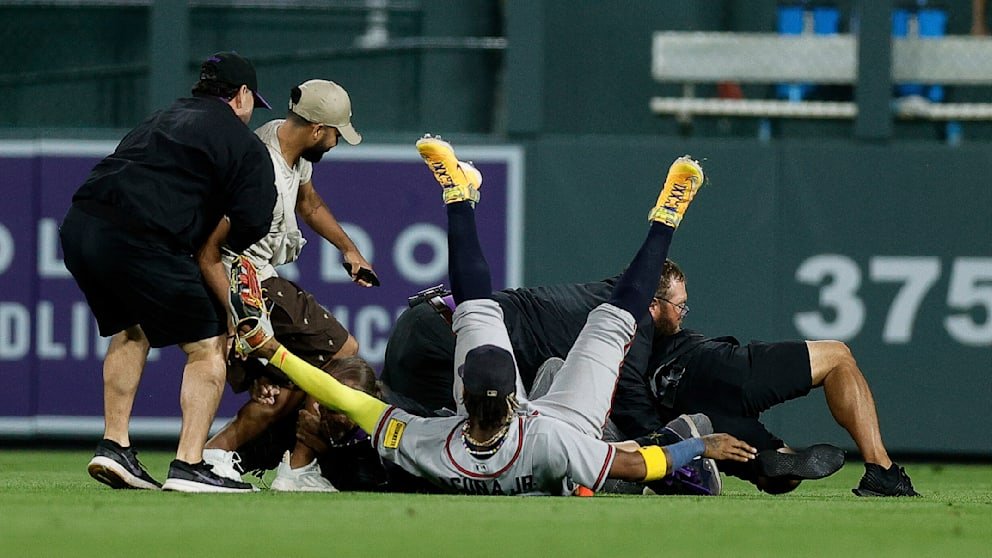
It’s not like baseball hasn’t seen fans on the field before— sometimes thousands of them. Remember when Hank Aaron hit home run No. 715? He was chased around the base paths by fans in Atlanta who’d somehow gotten past security. One of whom, Craig Sager, went on to have a lengthy sports broadcasting career.

Yankee Stadium crowds often mobbed the field in the 1970s, forcing players like Reggie Jackson to fight their way to the clubhouse to save their skins and, maybe, their caps. MLB has managed to discover security in the years since then, the protective netting surrounding the field providing a barrier to overly refreshed fans from taking an idiotic lap around the field.

That’s why the sight of, not one, but two fans being allowed to get to Atlanta’s superstar Ronald Acuña Jr. in centre field in Denver was so shocking. The first fan had time to awkwardly hug Acuña before, belatedly, a few porky security dudes finally hustled out to help. In doing so, Acuña, the runaway favourite for NL MVP— was knocked to the ground.
As more Rockies security emerged, a second fan joined in the untidy melée. After a brief scuffle the fans were bodily carried from the field. Only at the very end of this did any of Acuña’s teammates come out to help. The pair of intruders were arrested and charged.
An unhurt Acuña played down the incident afterward, talking about the men just being fans, a little over-excited etc. Maybe. But in a time where security is breaking down in stores, government buildings and schools, laughing off the episode is folly. In that context, the invasion of the field represented a massive security fail on behalf of MLB, the Rockies and the game-day staff.
First, players are told that in these situations they are to head immediately to the dugout. Acuña did not, waiting for the intruders. Second, the security staff were critically slow. The fan had ample time to create a worse confrontation before the other staff— and the second intruder— arrived on scene. Third, Acuña’s teammates were strangely reticent to come to his aid. Fourth, the areas of entry to the field were not properly supervised. Fifth, the umpires should have cleared the field. Instead the Braves pitcher was allowed to continue his warmup on the mound.
Fail. Fail. Fail. Fail. Fail.
Again these scenes have happened before, shrugged off as a lark by a drunk fan. Why the big fuss? The answer is context. In a time when MLB is trying to get fans as close their heroes as possible (see the Blue Jays new bullpens) the league has now shown it can’t control an emergency. Other leagues have had varying degrees of success. The NHL has very few intrusions on-ice anymore since high glass and netting made invasions nearly impossible.
But players in all sports still must pass through gauntlets of fans wanting a touch of the hand or a souvenir. In this regard golf and tennis are whistling past the graveyard as fans can stand in arm’s length of a golfer or interface with tennis stars at courtside. Just attend a PGA Tour event— most are like frat parties— and you’ll know how hard it would be to contain trouble if it got any momentum.
In the bigger picture, Canadians and Americans have come to accept that the people who are entrusted to keep the criminal element in their place are not doing their job. Like the Rockies staff they show up late— if they show up at all. And the perps are quickly back on the street due to new bail laws and hyper-liberal judges and crown attorneys. (Except if you’re a truck driver.)
Every major Canadian city— and a few secondary places as well— is now a squat zone for the homeless, the addicted and the politically insane. Here’s Ottawa: . Here’s Calgary: Here’s Toronto: They’re not exceptions. There are now no-go sections of these formerly safe places where unspeakable acts are performed on a sidewalk or in a park, menacing people in their everyday activities. Children must pass by the human detritus of needles and junk. Authority seems non-existent.
Large American cities like San Francisco, Los Angeles, Chicago and New York (among many) are also being preyed upon by organized gangs who swarm stores, gutting even high-end outlets like Nordstroms, Saks and Gucci in a blur of action, departing the scene in every direction. At times they use stolen cars to break through security. Many of these stores are closing their inner-city outlets.

Who are these thugs? Some are lifetime criminals, some are illegal immigrants, some are junkies, some are joyriders, out for a lark. Absent proper housing and mental healthcare they spill out in the streets knowing that laws about shoplifting have been forgotten (thanks to municipal councils replete with bleeding hearts). In the midst of this, the VPOTUS urged citizens to pay the bail of those who burned American cities for six months after George Floyd. That’s a deterrent, huh?
Knowing that the legal system is debased by Woke prosecutors and clown politicians such as AOC (“They’re just putting bread on the table”) they act with impunity. As often as not those protecting stores are charged for injuring the criminals. Managers tell staff to instead turn the other cheek to rampant theft.
For the most part the fanciful liberals who support ultra-permissive politicians have been immune from the impact of electing fools and revolutionaries. But now, the mayor of NYC is crying the blues because the illegals he thought should be kept in border states are now roaming his streets, flooding social services and jails. Ditto mayors in many other Democrat-run cities who see the migrant bussed to their streets.
In Canada, the current Liberal government has set a target of 40 million people in this country by 2026. Where are these new people to live? Where are they to work in cities with insane housing supply? Who will pay for their healthcare when personal physicians are as rare as Toronto Stanley Cup triumphs since 1967? Trudeau has no answers, just word salads blaming Stephen Harper.
It’s gotten so people now look at the attack on Ronald Acuña in a baseball park and say, “More of the same.” The breaking point is near. Should anyone choose not to do something about it.
Sign up today for Not The Public Broadcaster newsletters. Hot takes/ cool slants on sports and current affairs. Have the latest columns delivered to your mail box. Tell your friends to join, too. Always provocative, always independent. https://share.hsforms.com/16edbhhC3TTKg6jAaRyP7rActsj5
Bruce Dowbiggin @dowbboy is the editor of Not The Public Broadcaster A two-time winner of the Gemini Award as Canada’s top television sports broadcaster, he’s a regular contributor to Sirius XM Canada Talks Ch. 167. Inexact Science: The Six Most Compelling Draft Years In NHL History, his new book with his son Evan, was voted the seventh-best professional hockey book of all time by bookauthority.org . His 2004 book Money Players was voted sixth best on the same list, and is available via http://brucedowbigginbooks.ca/book-personalaccount.aspx
Bruce Dowbiggin
Lather, Rinse, Repeat: Recycling Coaches In The NHL
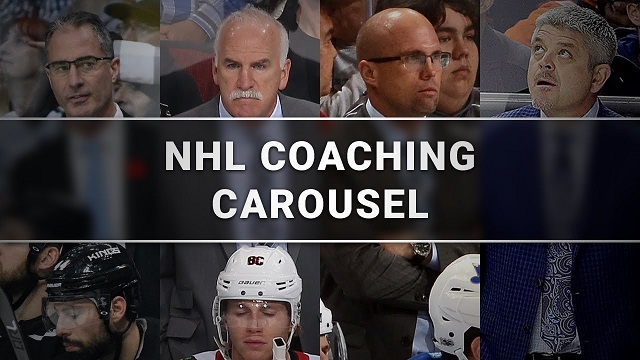
“The world will ask you who you are, and if you do not know, the world will tell you.” Carl Jung
As long as you’re willing to re-locate frequently the job of NHL head coach has a fair degree of job security. Even when you get fired it seems there’s a ready appetite in some other town for a skill set you have just failed at.
Latest evidence that failure has an I and U in it: Having canned Sheldon Keefe after a lengthy (note: sarcasm) five years at the helm of the Toronto Maple Leafs, club management scoured the bushes to find former player Craig “Chief” Berube, who has previously hung his coaching shingle in Philadelphia and St. Louis, where he won a Stanley Cup as an interim coach.

Chief wasn’t the glamour name (we were praying for Bruce Boudreau.). If the idea is how do the Leafs motivate their four mega-millionaires, he’s more like Mike Babcock than Sheldon Keefe. He won’t look at players’ cell phones, but he will give them that old-time religion. Knowing Chief from his Calgary days we’d say he can probably take the Toronto fishbowl.
(For those with long Leafs’ memories Berube was part of a famous trade in 1992 to which we devote an entire chapter in our new book Deal With It. He went west to Calgary while Doug Gilmour headed east to Toronto in the massive 10-man trade. While the Leafs “won” the trade, only the maligned Gary Leeman and journeyman Jamie Macoun won Cups– for teams other than Calgary and Toronto.)

But we digress. Sometimes it seems that NHL teams would rather lose with a known commodity than win with someone bold and unconventional behind the bench. While almost 30 percent of NHL players are European there have only been two European heads coaches, none in the past 20 years. Why? NHL owners are risk averse. And the league is a fraternity of forgiveness for guys you played junior with.
A brief ramble through the 2023-24 coaching roster shows several peripatetic bench bosses, led by the inimitable John Tortarella, who wore out his welcome in Vancouver, Tampa Bay, NY Rangers and Columbus before Philly curiously decided he had something left to offer. Let’s also not forget Lindy Ruff, who was pink slipped in Buffalo, Dallas, New Jersey and the NY Rangers— and now has been resurrected in Buffalo as a “fresh voice”.
Some retreads are getting results. Peter Laviolette has the Rangers into the third-round of the 2024 postseason, after gigs in Carolina, Philadelphia, Nashville, Washington (pause for breath) and the NY Islanders. Paul Maurice, currently guiding Florida in the playoffs, has had two stints with Carolina, plus Toronto and Winnipeg. Peter DeBoer, whose Dallas Stars are odd-on faves to with the 2024 Cup, has also coached Florida, San Jose, New Jersey and Vegas.
You want more? Rick Tocchet was head coach in Arizona and Tampa Bay before getting the perch in Vancouver. Travis Green, newly hired in Ottawa, has previously been found wanting in Vancouver and New Jersey. We could go on.

The king of the coach-for-life carousel is the just-retired Rick Bowness who finally called it a day in Winnipeg after the Jets were eliminated this spring. How long has Bones been knocking around? He was the coach of the expansion Ottawa Senators in 1992, one the worst five teams ever by NHL standards. Wonderful man who also spent stints as an assistant in cities in 30-plus years around the continent.
There are more. Sitting in the green room, polishing their pregame speeches are the well- travelled Boudreau, Dallas Eakins, Gerard Gallant, Todd McLellan, Claude Julien and Mike Yeo. Heaven forbid someone might still ask one of the Sutters to saddle up again. Brian (St. Louis, Chicago, Boston, Calgary), Darryl (Calgary, L.A., Anaheim, San Jose and Calgary again) and Brent (Calgary, New Jersey) have been perennial NHL coaching prospects for decades.

So take, heart, Sheldon Keefe. Joining Keefe in looking for a rebound job are Scott Arniel, Jeff Blashill, Jeremy Colliton, Kevin Dineen, Phil Housley, Kirk Muller, Davis Payne, Todd Reirden, Joe Sacco, Brad Shaw, Geoff Ward and Trent Yawney. Good company.
Don’t cry too hard for these coaching candidates. Unless they have years left on contract (Keefe has two) most wait out the time between head-coaching stints by accepting assistant-coach positions. The ranks of assistants contain a second tier of talent, also ready to go at a moment’s notice.
There are a scant few who’ve hung on in one town. Jon Cooper has been in Tampa since 2013, a Methuselah stint in today’s terms. Rod Brind’Amour has managed to avoid the chop in Carolina since 2018. But the reality is that, since the start off the 2023-24 season alone, there have been 13 head-coaching changes in the NHL. Go back to January of 2023, and 19 of the league’s 32 teams have changed coaches.
Which brings us back to the original idea: “Is there no one in international hockey who knows anything?” We won’t profess to be coaching talent scouts, but the idea that no one working outside North America can meet the job description better than some— if not most—of the coaches mentioned above beggars the imagination.
One final note: If you’re looking for an explanation of the coaching carousel and its recent frequency, look no further than Gary Bettman and his salary cap obsession. By forcing a hard cap on teams he’s concentrated the money— and the power— on a few players per team. When a coach is pitted against his stars it’s a no-win proposition.
The Leafs stars used their power to get Babcock fired. And it’s been repeated on other teams. While Keefe didn’t lose his Core Four he also couldn’t get them to win in the postseason. For that he got the chop— and a premium place in the next coaching carousel.
Bruce Dowbiggin @dowbboy is the publisher of Not The Public Broadcaster A two-time winner of the Gemini Award as Canada’s top television sports broadcaster, he’s a regular contributor to Sirius XM Canada Talks Ch. 167. Now for pre-order, new from the team of Evan & Bruce Dowbiggin— Deal With It: The Trades That Stunned The NHL & Changed Hockey. From Espo to Boston in 1967 to Gretz in L.A. in 1988 to Patrick Roy leaving Montreal in 1995, the stories behind the story. Launching in paperback and Kindle on #Amazon this week. Destined to be a hockey best seller. https://www.amazon.ca/Deal-Trades-Stunned-Changed-Hockey-ebook/dp/B0D236NB35/
Bruce Dowbiggin
Jerry Came to See The Babies. And They Walked Out On Him
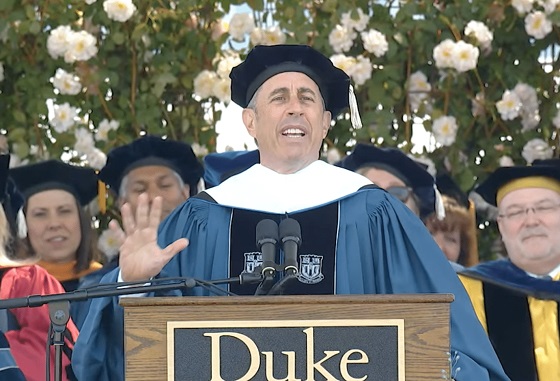
Cometh the hour, cometh the comedian. Or, you can learn a lot about a demographic by what makes them laugh.
The legacy/ lunacy media schvitzed itself over a few furious sociology majors and look-at-me drama queens walking out on Jerry Seinfeld’s commencement address at Duke University last weekend. But the significance of his admission that he was 70 was probably far more newsworthy to those now in retirement, binge-watching his eponymous TV series on one of those down-the-dial channels.
If we had a dollar for every Boomer who said, “Seinfeld is 70?” while watching the address we’d be Warren-Buffett-rich this morning. He doesn’t look like any 70 year olds we know. Fifty? Maybe. But listening to his familiar delivery, the mocking on his honorary degree costume, it was easy to believe that we, too, are much younger than our blood-thinner prescriptions say.
It also pointed out the evolution of Boomers’ comedic tastes. When they came of age in the late 1960s/ early 1970s Woody Allen best profiled as his generation’s comedic muse. With a dozen classic movies ranging from What’s New Pussycat (1965) through Play It Again Sam (1972) to Annie Hall (1977) Allen’s self-deprecating nebbish captured the romantic/ridiculous self-image of Boomers with “Some drink deeply from the river of knowledge. Others only gargle”.

The neurotic, insecure Allen then decided to become Ingmar Bergman, and Boomers— now assembling jobs, children and first spouses— moved on. But for that 12-year span the bedraggled standup comedian was the go-to with lines like “Just because you’re paranoid doesn’t mean they aren’t out to get you” and “The only love that lasts is unrequited love.”
Woody’s pointed contemporary political references in those years were few (conflating “D’you” for “Jew” with Tony Roberts in Manhattan) and self-deflating (see Annie Hall). His most prominent political jabs were framed in absurdist material like Love And Death and Bananas. Culturally he was merciless but affectionate about his Brooklyn upbringing. In short his were perfect date movies for Boomers seeking love to advertise their pretensions.
Flash forward from Woody to Seinfeld (created with Larry David) which was anti-romantic in the extreme. The characters were sociopaths. The situations often cringeworthy. The 24-minute formula harkened back to Lucy and the Honeymooners. And while schlock like Friends trod the same ground it was Seinfeld that somehow captured the Boomer zeitgeist.
Why? Boomers going through middle age were too disillusioned with how life was turning out to romanticize anymore. The self-obsessed characters were people they knew from work, school and dealing with government. Smirking Bill Clinton was the face of an era. “When we did my show in the 90s, it was so easy to make fun of things. It was so easy,” Seinfeld told Amy Schumer.
Significantly, Seinfeld the Show was cultural. Or quasi-cultural. It was never about politics per se. It was about the people who thwart you in life. Whose vanity ruins your plans from school days. Who go 50 mph in the left lane. “When is Jerry going to see the baby?” It rarely challenged its fans on an emotional level. It was mostly about navigating madness.
And often about the most mundane elements of life. The address on the weekend contained The Seinfeld Doctrine of Lowered Expectations. “It’s easy to fall in love with people. I suggest falling in love with anything and everything, every chance you get. Fall in love with your coffee, your sneakers, your blue zone parking space. I’ve had a lot of fun in life falling in love with stupid, meaningless physical objects.
“The object I love the most is the clear-barrel Bic pen — $1.29 for a box of 10. I can fall in love with a car turn signal switch that has a nice feel to it, a pizza crust that collapses with just the right amount of pressure. I have truly spent my life focusing on the smallest things imaginable, completely oblivious to all the big issues of living.”
Reaching across the generations Seinfeld delivered Dad jokes and bromides to kids who education probably cost $100 K a year. “I think it is also wonderful that you care so much about not hurting other people’s feelings in the million and one ways we all do that,” he said. Then he explained why that might be a fruitless pursuit. Not in Curb Your Enthusiasm darkness. But sobering.
That’s why it was in character for him to let the furious demonstrators depart at Duke without comment. So was appearing at Duke, the Ivy League of Tobacco Road, founded by the people who made jillions selling nicotine. And why he let them garb him like Thomas Cromwell in the absurd 16th century cape and hat so he could score few laughs.

Because laughter is his means of dealing with jerks like the outbound Hamas crowd. “What I need to tell you as a comedian: Do not lose your sense of humour. You can have no idea at this point in your life how much you are going to need it to get through. Not enough of life makes sense for you to be able to survive it without humour.”
Yes, He has been vocal lately about the effect of political correctness ruining TV comedy. Drawing flak from former friends and fans who are in the Biden re-education camps at the moment. But his annoyance at ruining an art form far outweighed any complaints about Covid and Ukraine.
As opposed to the nihilism of his former partner David, his insouciance and comic patter represent an antidote for where most of his original fans are at the moment. Woody Allen, their former idol, is now seen as a pedo and a failed nouveau vage auteur. Disillusioned with virus lies, electoral shenanigans and soaring prices, Boomers on a pension are unanchored, floating through what used to be North American society (when only women had babies).
In fact, Boomer spectators watching Seinfeld’s 17-minute speech maybe summed it up for themselves by recalling the Seinfeld mantra, “It was a show about nothing.” And they’d be right. Jerry is the man for those times.
Bruce Dowbiggin @dowbboy is the publisher of Not The Public Broadcaster A two-time winner of the Gemini Award as Canada’s top television sports broadcaster, he’s a regular contributor to Sirius XM Canada Talks Ch. 167. Now for pre-order, new from the team of Evan & Bruce Dowbiggin . Deal With It: The Trades That Stunned The NHL & Changed Hockey. From Espo to Boston in 1967 to Gretz in L.A. in 1988 to Patrick Roy leaving Montreal in 1995, the stories behind the story. Launching in paperback and Kindle on #Amazon this week. Destined to be a hockey best seller. https://www.amazon.ca/Deal-Trades-Stunned-Changed-Hockey-ebook/dp/B0D236NB35/
-
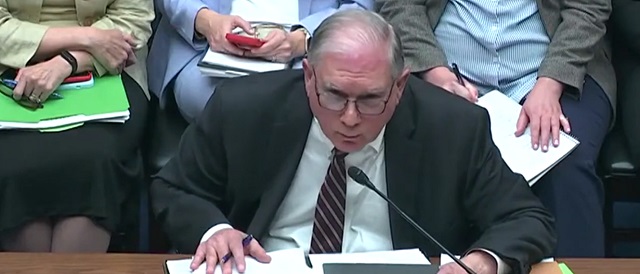
 COVID-192 days ago
COVID-192 days agoTop Fauci Aide Allegedly Learned To Make ‘Smoking Gun’ Emails ‘Disappear,’ Testimony Reveals
-
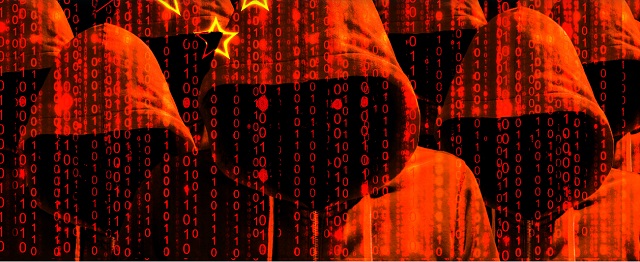
 COVID-191 day ago
COVID-191 day agoThe Vials and the Damage Done: Canada’s National Microbiology Laboratory Scandal, Part II
-

 Bruce Dowbiggin4 hours ago
Bruce Dowbiggin4 hours agoLather, Rinse, Repeat: Recycling Coaches In The NHL
-

 Censorship Industrial Complex14 hours ago
Censorship Industrial Complex14 hours agoAustralia passes digital ID bill, raising fears of government surveillance without accountability
-

 International14 hours ago
International14 hours agoIran’s President Ebrahim Raisi, who oversaw mass executions, dies in helicopter crash
-

 Opinion13 hours ago
Opinion13 hours agoUK set to ban sex ed for young children amid parental backlash against LGBT indoctrination
-

 DEI3 hours ago
DEI3 hours agoLawmakers press investigation into DEI agenda at the Pentagon
-

 Brownstone Institute1 day ago
Brownstone Institute1 day agoEnough With These Dangerous Calculations








